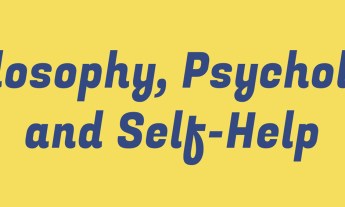
Most of us live with a constant stream of internal statements, criticisms and commands running through our heads. But we have a choice: We don’t have to let them define us — or our days, says psychology researcher Steven Hayes. Here’s how we can disentangle ourselves.
When we’re worried or dissatisfied, most of us will do anything not to feel these feelings. Instead, we avoid them, search for something to distract or soothe ourselves, or try to problem-solve our way out of them.
Acceptance and Commitment Therapy (ACT) takes a different tack — it’s all about cultivating the psychological flexibility so we can live with what’s unpleasant and not let it run our lives. “Changing our relationship to our thoughts and emotions, rather than trying to change their content, is the key to healing and realizing our true potential,” says Steven C. Hayes, psychology professor at the University of Nevada, Reno, and the originator and pioneering researcher of ACT.
Hayes and other colleagues have found that psychological flexibility is made up of six core skills, including one that they call “defusion.” Below, Hayes explains what it is and how we can learn to build it.
Much of the time, most of us are living in a state of cognitive fusion — fully buying into what our thoughts tell us and allowing them to overly direct our actions and choices. This happens because we’re programmed to notice the world as structured by our thoughts but we miss the fact that we are the ones thinking these thoughts.
The flip side of fusion is when we see our thoughts for what they really are — namely, ongoing attempts to make meaning of the world — and we give them power only to the degree that they genuinely serve us. We’re able to notice the act of thinking, without diving in or getting entangled in our thoughts. Our made-up word for this act of noticing is “defusion.”
Helpful in learning defusion is understanding the yearning that drives our obsessive self-chatter and problem solving. It’s a yearning to create coherence and understanding out of our mental cacophony, and it’s a perfectly understandable desire. We feel vulnerable when our thoughts don’t fit nicely together, especially when they are contradictory.
The first step in making the pivot away from believing our automatic thoughts is to become aware of just how complicated our thought processes are. One way to start is to give your mind free rein to think for a few minutes and then write down the string of thoughts that emerge.
I did this exercise as soon as I woke up one morning I was writing this book, and here were my thoughts:
It’s time to get up. No, it isn’t; it’s only 6:00. That’s seven hours of sleep. I need eight — that’s the goal. I feel fat. Well, birthday cake, duh. I have to eat cake on my son’s birthday. Maybe, but not such a big piece. I bet I’m up to 196 lbs. Shoot … by the time I run the Halloween candy/Turkey Day gauntlet I’ll be back over 200. But maybe not. Maybe more like 193. Maybe exercise more. Anything would be “more.” I’ve gotta focus. I have a chapter to write. I’m falling behind … and I’m getting fat again. Noticing the voices and letting them run might be a good start to the chapter. Better to go back to sleep. But maybe it could work. It was sweet of Jacque to suggest it. She’s up early. Maybe it’s her cold. Maybe I should get out of bed and see if she is OK. It’s only 6:15. I need my eight hours. It’s close now to seven and a half hours. Still not eight.
Not only are these thoughts remarkably circuitous, but most of them are about rules and punishment. Many of them are also contradictions of prior thoughts. This kind of mental to-and-fro is probably familiar to you.
Arguing with ourselves comes naturally to most of us. In fact, the old cartoon device of a devil on one shoulder and an angel on the other is understood even by small children. When we are deeply focused on a mental task, our minds enter into a state of flow, in which our thoughts, emotions and actions are all temporarily in sync. But our more usual state is one of mind wandering, which is often characterized by a good deal of mental disagreement and disengagement.
To get a look at how automatic and circuitous your own thinking is, take a minute to point your thoughts in any direction of your choosing. Then, track them as they run their course. Write down everything you notice.
After completing this exercise, repeat it two more times, letting your thoughts run for one minute each time. In round two, imagine that your job is to figure out whether each thought is true or appropriate. In round three, imagine that your thoughts are like the voices of quarreling first-graders. Adopt a posture of curiosity and amusement, but do nothing except for notice them.
In round two, you probably experienced the sense of being pulled directly into your thoughts. Their loudness may have increased; your focus on their content may have gone up. You might have gotten into an argument with your mind. In round three, you probably notice the general flow of your thoughts. Very likely, the specific content seemed less important, and you had a sense of being outside any arguments.
That difference explains how defusion exercises weaken the link between automatic thoughts and behavior. Our ability to step back from our thoughts grows stronger as we practice. When we learn defusion skills, we can take the energy of our counterproductive yearning and pivot it toward learning to be gently guided by our experiences.
Here’s a starter set of commonly used defusion techniques. The first two are general defusion-building exercises, and the others are tailored to defusing from specific problematic thoughts. Consider these to be the core of your defusion practice. In your first couple of weeks, repeat each one at least once a day. Additionally, if during the course of the day you notice that you are ensnared by a thought, use a couple in the moment to break free.
While it’s common and even helpful for you to feel a sense of freedom and distance in a matter of minutes after practicing these exercises, be careful. Your mind may try to convince you that you have solved your problems. Don’t believe it: your inner dictator is just giving you a dangerous new thought to defuse from.
No matter how good you are at defusion, your mind will keep forming new thoughts that you’ll naturally fuse with. One example is thinking: “I’m the world’s expert in defusion!”. It’s vital for you to stay aware of this tendency. I’ve been practicing defusion for more than 30 years, and I still have to catch myself every day as I get entangled with my thoughts. For me, sometimes just catching my thoughts is enough to break the grip, but if not, I immediately engage in one of these practices. However, fusion still sometimes slips by me for a while. Your goal is progress, not perfection.
One last warning: Some of these exercises may seem odd, even silly. We humans are funny creatures! Just work through them with a sense of self-compassion.
1. Disobey on purpose
Let me start with one that I’m sure will seem perplexing. Just trust me. Stand up and carry a phone, book or other object with you while you slowly walk around the room, reading this next sentence aloud several times. Yes, read this sentence while walking.
OK? Ready? Stand up. Walk. Read. Go!
Here is the sentence: “I cannot walk around this room.”
Keep walking! Slowly but clearly repeat that sentence as you walk at least five or six times. “I cannot walk around this room.” Now you can sit down again.
It is such a tiny thing, isn’t it? It’s a tiny poke in the eye of the Dictator Within — which is what I call the domineering problem-solving part of our minds that is constantly suggesting “solutions” for our psychological pain — and a little tug on your superhero cape.
This exercise was one of our earliest defusion discoveries. Even though it is a silly exercise, a team in Ireland showed recently in a laboratory experiment that it immediately increased tolerance to experimentally induced pain by nearly 40 percent. In the study, people were willing to keep their hand on a very, very hot plate (not hot to the point of injury but hot enough to cause real pain) 40 percent longer — after just a few moments of saying one thing while doing the opposite.
Even the smallest demonstration that the mind’s power over you is an illusion can give you significantly more freedom to do hard things. You can easily build this into your life as a regular practice (right now I’m thinking, “I cannot type this sentence!” as I’m typing).
2. Give your mind a name, and listen to it politely
When we listen to another person, we choose whether we agree with what they have to say (or not). With our internal voice, we don’t usually feel like we have that option to agree or disagree, but that’s the posture I’d like you to try taking. Research has shown that naming your mind — give it a name other than the one you call yourself — helps with this. Why? Because if your mind has a different name, it is different from “you.”
I call mine “George.” Pick any name you like — even Mr. Mind or Ms. Mind will do. Now say hello to your mind by using its new name, as if you were being introduced to it at a party. Of course, if you are around others while you’re reading this — say, on a bus or a train — do this in your head.
3. Appreciate what your mind is trying to do
As you listen to your thoughts and notice when your mind starts to chatter, answer it back with something like, “Thanks for that thought, George. Really — thank you.” If you speak to your mind dismissively, it will continue right on problem-solving, so be sincere. You might want to add, “I really get that you’re trying to be of use, so thank you for that. But I’ve got this covered.” Say this out loud if you’re alone, or internally if you’re with others.
Your mind will probably push back with thoughts like, “That’s silly — that won’t help!” Respond again with, “Thanks for that thought, George. Thank you — I really do see how you are trying to be of use.” You might consider inviting it to comment further by replying “Got anything else you have to say?”
4. Sing it
This method is powerful when you’re having a really sticky thought. Turn that thought into a sentence and try singing it — again, do this out loud if you are alone or in your head if you have company. Any tune will do. My default is “Happy Birthday.” Don’t worry about the wording or rhyming scheme — you are not auditioning for America’s Got Talent! Just repeat your thought to whatever tune you choose.
Now find a thought that is nagging you, and try this out. Experiment with different tunes, or sing it fast or slow. How will you know whether you’ve “succeeded”? It’s not that the thought goes away or becomes unbelievable; it’s that you can see it more clearly as just another thought.
5. Carry it with you
Write down a recurring, critical thought on a small piece of paper. Maybe it’s “I’m stupid” or “I’m unloveable” or “I’m going to fail.” After you finish writing, hold up the paper and look at it as if it were a precious and fragile page from an ancient manuscript. These words are an echo of your history.
Even if the thought is painful, ask yourself if you’d be willing to honor that history by choosing to carry this piece of paper with you. If you can get to “yes,” place it in your pocket, wallet or bag and let it come along for the ride. During the days you carry it, every so often pat your wallet or bag (or wherever you keep it) to acknowledge that it is part of your journey, and it is welcome to come along.
By practicing exercises like these, we can start laying down unhelpful thoughts that have driven us for years. If we learn to think of our internal voice as that of an advisor rather than a dictator, it can become enormously helpful to us. We come to see that our mind itself is not bad or harmful as long as we don’t let it rigidly dictate our behavior. It’s a tool and when we learn to put it on a leash, it can serve us even better.
Excerpted with permission from the new book A Liberated Mind: How to Pivot Towards What Matters by Steven C. Hayes. Published by Avery, an imprint of Penguin Random House, LLC. © 2019 by Steven C. Hayes.
Watch his TEDxUniversityofNevada talk now:












